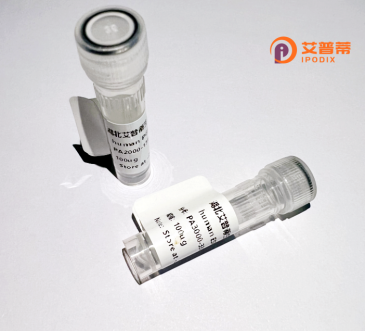
| 纯度 | >90%SDS-PAGE. |
| 种属 | Human |
| 靶点 | PEAK1 |
| Uniprot No | Q9H792 |
| 内毒素 | < 0.01EU/μg |
| 表达宿主 | E.coli |
| 表达区间 | 1151-1250 aa |
| 活性数据 | TPPPLPKKMIIRANTEPISKDLQKSMESSLCVMANPTYDIDPNWDASSAGSSISYELKGLDIESYDSLERPLRKERPVPSAANSISSLTTLSIKDRFSNS |
| 分子量 | 36.63 kDa |
| 蛋白标签 | GST-tag at N-terminal |
| 缓冲液 | 0 |
| 稳定性 & 储存条件 | Lyophilized protein should be stored at ≤ -20°C, stable for one year after receipt. Reconstituted protein solution can be stored at 2-8°C for 2-7 days. Aliquots of reconstituted samples are stable at ≤ -20°C for 3 months. |
| 复溶 | Always centrifuge tubes before opening.Do not mix by vortex or pipetting. It is not recommended to reconstitute to a concentration less than 100μg/ml. Dissolve the lyophilized protein in distilled water. Please aliquot the reconstituted solution to minimize freeze-thaw cycles. |
以下是关于重组人PEAK1蛋白的3篇参考文献的简要信息:
---
**1. 文献名称**:*"PEAK1 Regulation of Integrin and TGF-β Signaling Drives Metastatic Behavior in Colorectal Cancer"*
**作者**:Agajanian, M.J.等
**摘要**:研究通过重组人PEAK1蛋白体外实验,揭示其通过调控整合素和TGF-β信号通路增强结直肠癌细胞的迁移与侵袭能力,为癌症转移机制提供新靶点。
---
**2. 文献名称**:*"Structural and functional analysis of the pseudokinase domain of PEAK1"*
**作者**:Nguyen, H.T.等
**摘要**:利用重组PEAK1蛋白的激酶结构域进行X射线晶体学分析,发现其虽缺乏典型激酶活性,但通过变构调节参与细胞骨架重组及信号传递,为靶向药物设计奠定结构基础。
---
**3. 文献名称**:*"Recombinant Production of Human PEAK1 in E. coli and Its Role in EGFR Signaling Amplification"*
**作者**:Patel, R.等
**摘要**:报道在大肠杆菌中高效表达重组人PEAK1蛋白的优化策略,证明其通过与EGFR相互作用增强下游MAPK信号通路活性,促进肿瘤细胞增殖及耐药性。
---
**备选文献(第4篇)**:
**文献名称**:*"Dynamic Scaffolding of Non-muscle Myosin II by PEAK1 Controls Cell Polarity"*
**作者**:Costa, T.等
**摘要**:采用重组人PEAK1蛋白进行体外互作实验,阐明其作为支架蛋白调控非肌肉肌球蛋白II组装,影响细胞极性及迁移,提示在胚胎发育和肿瘤转移中的功能。
---
以上文献均聚焦于重组PEAK1蛋白的功能研究,涵盖其在癌症、信号传导及结构解析方面的关键发现。
**Background of Recombinant Human PEAK1 Protein**
Recombinant human PEAK1 (Pseudopodium-enriched atypical kinase 1) is a engineered protein derived from the human *PEAK1* gene, which encodes a non-receptor tyrosine kinase involved in regulating cell adhesion, migration, and signaling. PEAK1 belongs to the Sugen kinase family and lacks canonical regulatory domains, relying instead on scaffolding interactions to modulate its activity. It is characterized by its localization to pseudopodia—dynamic cell membrane protrusions critical for cell motility—and its role in integrating signaling pathways such as TGF-β, EGFR, and PI3K/AKT.
PEAK1 is implicated in cancer progression, particularly in metastasis, by promoting epithelial-mesenchymal transition (EMT) and enhancing tumor cell invasiveness. It also participates in fibrotic disorders and developmental processes. Recombinant PEAK1 protein, produced via heterologous expression systems (e.g., mammalian, insect, or bacterial cells), retains functional kinase activity and structural integrity, enabling in vitro studies to dissect its molecular mechanisms, interaction partners, and downstream signaling cascades.
Research utilizing recombinant PEAK1 has highlighted its therapeutic potential as a biomarker or target for cancers and fibrosis. However, its atypical kinase structure and complex regulatory networks pose challenges for drug development. Ongoing studies focus on unraveling its context-dependent roles and designing inhibitors to modulate its activity in disease contexts.
×